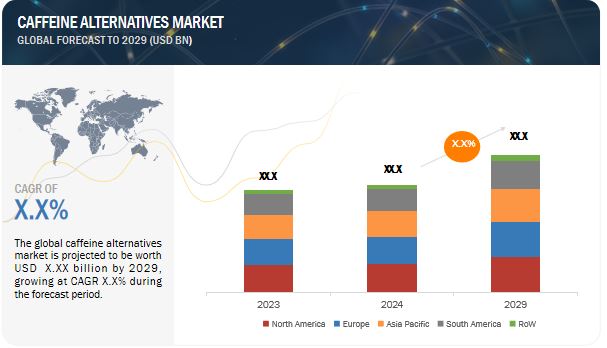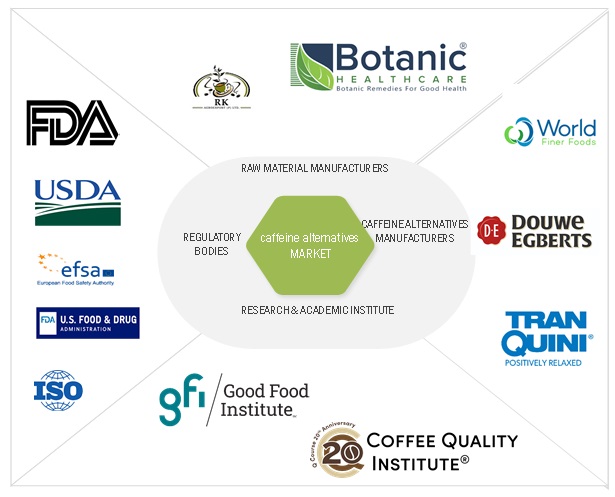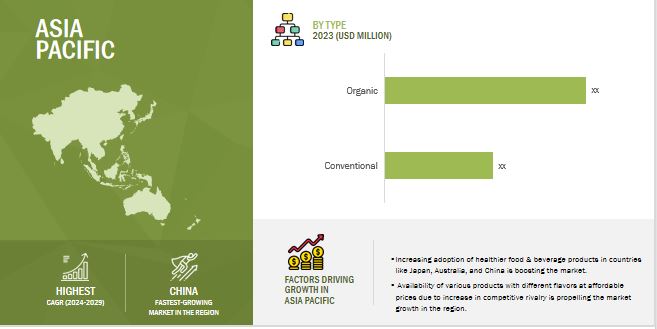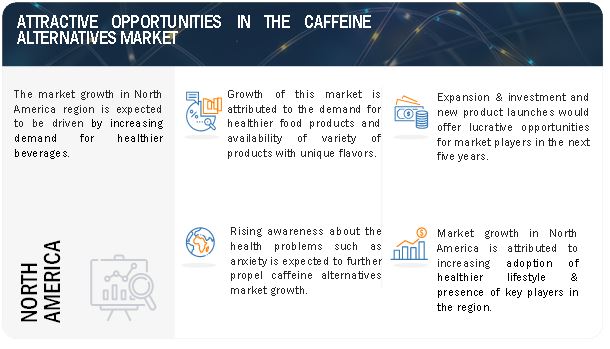Caffeine Alternatives Market by Type (Herbal Alternatives, Grain-Based Alternatives), Form (Powder, Liquid, Capsules/Tablets), Distribution Channel (Hypermarket/Supermarket, Convenience Stores, Online), and Region - Global Forecast to 2029
According to MarketsandMarkets, the caffeine alternatives market is projected to reach USD X.XX billion by 2029 from USD X.XX billion by 2024, at a CAGR of 8.8% during the forecast period in terms of value. The market for caffeine substitutes is expanding rapidly due to a number of variables that meet changing consumer demands and health-conscious tendencies. Customers are looking for alternatives to typical caffeinated beverages like coffee and energy drinks as health consciousness continues to rise globally. This change is mostly driven by worries about the possible negative health consequences of consuming large amounts of caffeine, like insomnia and elevated anxiety. In addition, there is a growing market for natural and plant-based components in beverages and supplements due to the growing emphasis on wellness and sustainable lifestyles. Companies in the caffeine substitutes market are taking advantage of these developments by experimenting with new components including vitamins, herbal extracts, and adaptogens, which provide energy without the use of stimulants while also enhancing general wellbeing. Increased consumer knowledge of the wide range of functional advantages provided by caffeine substitutes, such as better metabolic support, stress relief, and cognitive performance, is also helping the industry.

To know about the assumptions considered for the study, Request for Free Sample Report
To know about the assumptions considered for the study, download the pdf brochure
Market Dynamics
Driver: Increasing focus on healthier food & beverage products
The market for caffeine substitutes is expanding significantly, primarily due to a shift in consumer preferences toward wellness and health. Consumers are looking for healthier solutions as a result of growing knowledge of the possible drawbacks of traditional caffeine sources like coffee and energy drinks, such as jitters, insomnia, and reliance. Growing consumer preference for goods seen to be natural and good for general wellbeing is supporting this trend. The beverage sector has seen a rise in innovation as a result of these changing consumer tastes. Producers are launching a broad range of caffeine substitutes, including vegan, gluten-free, and organic options, to suit a variety of dietary requirements and tastes. These substitutes typically contain vitamins, herbal extracts, adaptogens, and natural stimulants in an effort to mimic the benefits of coffee while still offering energy and alertness.
Restraint : Strong inclination towards conventional sources
The strong inclination and cultural commitment that consumers have to conventional sources such as coffee poses a major challenge to market participants operating in the caffeine alternatives space. In many nations, coffee holds deep cultural value, therefore it might be difficult for users to entirely transition to other options. The adoption of new goods in the caffeine substitutes market is hampered by this cultural inertia, necessitating intensive marketing campaigns and educational initiatives to modify consumer attitudes and habits.
Opportunity: Rising demand for healthier beverage
Serving the expanding consumer desire for healthier and more varied beverage options is a big opportunity for companies in the caffeine substitutes market. Customers are looking for energy sources that don't have these negative consequences since they are becoming more aware of the possible negative impacts of excessive caffeine usage, such as problems sleeping, anxiety, and reliance. This makes the market for goods containing natural stimulants like yerba mate, guarana, or adaptogenic herbs like rhodiola and ginseng extremely fertile. Beverages that provide functional advantages beyond simple stimulation, such enhanced focus, mood enhancement, or stress reduction, are also becoming more and more popular. Companies who can match these demands through innovation in flavour, formulation, and branding will be able to take a sizable chunk of this quickly expanding industry.
Challenge: Consumer perception of the effectiveness and dependability
A major obstacle facing the market for caffeine substitutes is consumer perception of the effectiveness and dependability of these products in comparison to more conventional sources like tea and coffee. Because coffee and tea have been scientifically validated and have long been accepted in culture, many consumers see them as reliable sources of energy and stimulation. Convincing customers that caffeine substitutes can offer similar advantages without the possible downsides of regular caffeinated beverages—like jitters, disturbed sleep, or dependency—remains a difficult task. Players in the market for caffeine substitutes must use creative marketing techniques to emphasize the special qualities of their goods in order to overcome this obstacle. This entails stressing qualities like continuous energy release, lack of crash effects, and extra functional advantages like sharpened attention or decreased stress.
CAFFEINE ALTERNATIVES MARKET ECOSYSTEM
Key players within this market consist of reputable and financially robust caffeine alternatives manufacturers. These entities boast extensive industry tenure, offering diversified product portfolios, cutting-edge technologies, and robust global sales and marketing networks. Prominent companies in this market are World Finer Foods (US), Unilever (UK), Gourmesso Coffee (Germany), Douwe Egberts (Netherlands), Nestlé (Switzerland), Dilmah Ceylon Tea Company PLC (Sri Lanka), Ippodo Tea (Japan), Tranquini (Austria), ChillBev (US), Som Sleep (US), Rasa (US), Phi Drinks, Inc. (US), Lima Coffee Roasters (Peru), Dandy Blend (US), among others.

In the type segment, herbal alternatives holds the largest market share in the caffeine alternatives market.
The growing consciousness among consumers and their inclination towards natural and organic items has stimulated the market for herbal substitutes, which are regarded as more wholesome and secure than their synthetic equivalents. This trend corresponds with customers' increasing focus on wellness and clean label products. Furthermore, herbal substitutes are more appealing since they frequently provide extra health advantages including stress reduction, better digestion, and antioxidants. The increasing number of people who are sensitive to or intolerant to caffeine has also increased demand for softer substitutes; herbal remedies are a good way to satisfy this requirement. The effectiveness and flavor profiles of these products have been further enhanced by developments in herbal extraction methods, making them more enticing and practical for consumption.
In the form segment, powder form is expected to dominate the market during the forecast period.
Powdered substitutes are very flexible and convenient to use; they are especially useful for time-pressed customers who prefer simple, rapid fixes. This structure makes it simple to incorporate into a variety of drinks, like shakes and smoothies, successfully meeting a wide range of nutritional needs and tastes. Second, as compared to their liquid counterparts, powdered items usually have longer shelf lives and require less storage space, which makes them more convenient for retailers and customers alike. Taste characteristics and solubility have been further enhanced by technological breakthroughs in powder formulation, improving the whole customer experience. Powdered alternatives are also more appealing to producers and distributors because of their small packaging, which facilitates affordable shipping and distribution. Market awareness and consumer adoption rates have been greatly increased by strategic marketing campaigns that emphasize the powdered alternatives' convenience, nutritional advantages, and customizable options.
The supermarket/hypermarket segment in the caffeine alternatives market is expected to occupy the largest market share during the forecast period.
Supermarkets and hypermarkets house a variety of goods, including substitutes for coffee. Many customers who want to conduct all their shopping in one location are drawn in by this convenience. Shoppers seeking both conventional and non-traditional products, such as caffeine replacements, increasingly choose to visit these retail locations as they grow and enhance their offers. Supermarkets and hypermarkets generally maintain a varied assortment of products to accommodate a wide range of consumer tastes and dietary requirements. This encompasses a wider range of caffeine substitutes, including herbal teas, coffee that has been decaffeinated, caffeine-free energy drinks, and other beverages. These alternatives' availability at these businesses entices customers to investigate and buy them, which boosts sales.
The Asia Pacific region is expected to grow at highest CAGR in the caffeine alternatives market during the forecast period.
Asia Pacific is poised to grow at highest CAGR in the caffeine alternatives market in terms of sales due to several key factors. First and foremost, consumer awareness and demand for healthier lifestyle choices are significantly increasing in this region. Consumers in the region are increasingly seeking alternatives to traditional caffeinated beverages like coffee and energy drinks, driven by concerns over health, wellness, and sustainability. This trend is bolstered by a robust market for organic and natural products, where caffeine alternatives fit well due to their perceived health benefits and sustainable sourcing. Moreover, the region benefits from a diverse and innovative food and beverage industry that actively develops and promotes new products. This includes a wide range of caffeine-free alternatives such as herbal teas, decaffeinated beverages, and innovative functional drinks that offer energy boosts through natural ingredients other than caffeine.

Key Market Players
The key players in the market include World Finer Foods (US), Unilever (UK), Gourmesso Coffee (Germany), Douwe Egberts (Netherlands), Nestlé (Switzerland), Dilmah Ceylon Tea Company PLC (Sri Lanka), Ippodo Tea (Japan), Tranquini (Austria), ChillBev (US), Som Sleep (US), Phi Drinks, Inc. (US), Lima Coffee Roasters (Peru), Rasa (US), and Dandy Blend (US). These market participants are emphasizing the expansion of their footprint via agreements and partnerships. They maintain a robust presence in North America, Asia Pacific, South America, RoW, and Europe, and they are supported by manufacturing facilities and well-established distribution networks spanning these regions.
Recent Developments
- In April 2024, Rarebird Inc., received obtained a patent for the recipe for Px Coffee. The coffee produced by the company is made with paraxanthine (PX), a caffeine substitute designed to assist customers in reducing their caffeine use. This will help the company to maximize its product footprint.
- In January 2023, Rasa, launched two new premixes, Classic Rasa and Café Rasa, with mushrooms and adaptogenic herbs. This development has helped the company to widen its audience by increasing its product portfolio. The firm aims to serves customers from different demographic categories.
- In May 2023, Alt Health announced that it will enter US market with its caffeine-free coffee alternatives. With its line of caffeine-free coffee substitutes, Alt Health is changing people's lives. With the goal of assisting Americans in kicking their caffeine addiction without having to give up their energy or productivity in the process, the brand is currently expanding into the US market.
Frequently Asked Questions (FAQ):
Which are the major companies in the caffeine alternatives market? What are their major strategies to strengthen their market presence?
The key players in the market include World Finer Foods (US), Unilever (UK), Gourmesso Coffee (Germany), Douwe Egberts (Netherlands), Nestlé (Switzerland), Dilmah Ceylon Tea Company PLC (Sri Lanka), Ippodo Tea (Japan), Tranquini (Austria), ChillBev (US), Som Sleep (US), Phi Drinks, Inc. (US), Lima Coffee Roasters (Peru), and Dandy Blend (US). These players are focusing on increasing their presence through agreements and collaborations. These companies have a strong presence in North America, Asia Pacific, South America, and Europe. They also have manufacturing facilities and strong distribution networks across these regions.
What are the drivers and opportunities for the caffeine alternatives market?
The increasing demand for functional beverages is one of the factors propelling the market for caffeine substitutes. Beverages that offer additional health benefits in addition to satisfying thirst are becoming more and more appealing to consumers. Customers searching for beverages that promote general well-being, mental clarity, or stress reduction are drawn to caffeine substitutes that include components like vitamins, antioxidants, or adaptogens. Serving dietary needs and constraints presents an opportunity in the market for caffeine substitutes. For instance, there is a rising need for non-GMO, vegan, and gluten-free options in food and drink items, including caffeine substitutes. Creating goods that fit these requirements can help you stand out from the competition and draw in a larger customer base.
Which region is expected to hold the highest market share?
The North America region is expected to hold a dominant position in the caffeine alternatives market during the forecast period due to several critical factors. In terms of sales, North America is positioned to lead the market for caffeine substitutes for a number of important reasons. First and foremost, there is a markedly high level of consumer awareness and demand in this region for healthier lifestyle options. Concerns about sustainability, wellbeing, and health are driving consumers in North America to look for alternatives to typical caffeinated beverages like coffee and energy drinks.
What are the key technology trends prevailing in the caffeine alternatives market?
In the realm of caffeine alternatives, emerging technologies are revolutionizing production methods to meet growing consumer demand for healthier, sustainable options. One notable innovation involves advanced extraction techniques using supercritical CO2 or subcritical water extraction processes. These methods efficiently extract caffeine from natural sources like tea leaves or coffee beans, while preserving flavor and nutritional compounds. Another promising approach integrates biotechnological advancements, such as microbial fermentation or enzymatic processes, to produce caffeine-free coffee-like beverages. These technologies not only cater to health-conscious consumers but also contribute to reducing environmental impact by minimizing chemical solvents and waste generation. As these technologies continue to evolve, they promise to shape the future of caffeine alternatives with improved flavor profiles and nutritional benefits.
What total CAGR is expected to be recorded for the caffeine alternatives market from 2024 to 2029?
The CAGR is expected to be 8.8% from 2024-2029. .
To speak to our analyst for a discussion on the above findings, click Speak to Analyst

















Growth opportunities and latent adjacency in Caffeine Alternatives Market